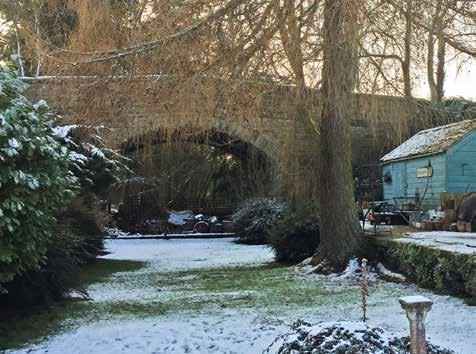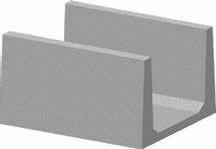
12 minute read
A bridge too far
GRAEME BICKERDIKE
A TOO FAR



CAMPAIGNERS FIGHT TO SAVE HUNDREDS OF DISUSED RAILWAY STRUCTURES THREATENED WITH INFILLING OR DEMOLITION
Scattered across our nation are relics of the transport revolution brought by the railway in the 19th Century and lost to another - driven by the motorcar - in the 20th. Fifty years ago, the idea that we might eventually reopen railways was fanciful, but the climate is changing, thanks partly to climate change and other emerging home-truths.
In January 2020, the Department for Transport established its Restoring Your Railway Fund - a £500 million pot aimed at kickstarting a reversal of the Beeching cuts. Of the 110 schemes submitted in the first two rounds of bidding, 25 have been awarded money to help the development of transport and economic studies, and create a business case; third round bids had to be submitted by 5th March.
And then there’s walking and cycling which saw a huge uptake during the first lockdown as we embraced green space and clean air. How did we not understand their value previously? But we are now beginning to match the social, health, wellbeing, environmental, economic and connectivity benefits on offer with proportionate investment in the safe, high-quality infrastructure needed to encourage more of us onto our feet and bikes. It needs better coordination, but it’s a start.
All this has created a different context through which to view our network of disused railways and the Victorian engineering feats that carry them through the landscape. There are thousands of old bridges, viaducts and tunnels out there - all of them liabilities in their redundant state, but many await conversion into assets that will make positive contributions.
The greatest single collection of 3,200 structures comprise the Historical Railways Estate (HRE) - owned by the Department for Transport and managed on its behalf by roads company Highways England.
Future roles
“The value of existing infrastructure must be recognised as we evolve to greener modes of transport”, says Gordon Masterton who chairs the Institution of Civil Engineers’ Panel for Historical Engineering Works. “Disused railways offer unique opportunities; many have already been repurposed through iconic active travel routes, enjoyed by millions of people every year.”
But dark clouds are gathering. In 2016, Highways England’s draft Strategic Plan for the Historical Railways Estate revealed an intention to demolish up to 480 structures between now and 2030, “to significantly reduce the level of liability and risk”. Some demolitions are already planned as part of an ongoing first phase, with 115 bridges and tunnels earmarked for infilling.
The impact is significant. An appraisal by The HRE Group - an alliance of engineers, cycling campaigners and greenway developers - has found that the routes of six proposed cycle paths would be blocked by Highways England’s plans whilst extensions to heritage lines in Angus, Cumbria and Norfolk would also be affected, together with three railway reopenings. In all, about one-third of the 115 structures have clear potential value for future transport projects.
Most councils have now developed infrastructure plans for the expansion of their local active travel networks, a cornerstone of the Government’s ambitious long-term approach set out in its 2015 Cycling and Walking Investment Strategy; £2 billion of associated investment was announced last May. Whilst that’s great news, the actions of Highways England - supported by the DfT - do not sit comfortably alongside. Demolition and infilling undermine the business cases for schemes that are only sustainable because the railway alignments they’re based around are currently unobstructed. It’s causing anger and anxiety amongst communities who see a better future being snatched from them.
Selection criteria
Back in January, a Highways England spokesperson told media outlets that “around 200 of the public road bridges managed by HE/ HRE have failed their most recent structural assessment (BD21) but haven’t had any [weight] restrictions implemented. Therefore, our planned infilling is the safest and most appropriate option and will maintain access across the structure.” An HRE bridge with a weight restriction in North Yorkshire.

PHOTO: THE HRE GROUP
(Opposite page) Protestors occupy a bridge near Oxford after contractors turned up unexpectedly and starting demolishing the parapets.
(Opposite page, bottom) A threatened bridge in North Yorkshire.

PHOTO: THE HRE GROUP CYCLE PATH? 1

CYCLE PATH? 3
PHOTO: ROSS COWAN
Overbridges to be infilled at... (1) Alnwick, Northumberland (2) Hampstead Norreys, Berkshire (3) Uplawmoor, East Renfrewshire.
(4) Underbridge to be demolished at Toller Porcorum, Dorset.

This was misleading as 55 (48%) of the 115 bridges slated for infilling are not amongst these “around 200” structures. And the real figure is 169. And 14 of these do have weight restrictions. And dating from pre-1922, they’re neither expected nor required to pass BD21 assessments; a legacy Standard, BE4, applies. But apart from that.
It’s perhaps worth noting that the preamble to BD21 made clear that “Many of the bridges to be assessed by this Standard are of considerable age and represent important features of our cultural heritage. Their survival to this day owes a great deal to the care of past generations. Where remedial or strengthening works are found to be necessary, the proposals should reflect the duty to retain the character of these structures for the benefit of future generations. Early remedial measures, which restore the carrying capacity and extend the life of these structures, are preferable to urgent reconstruction, as the former not only prove generally to be more cost-effective, but also retain the existing character of these structures.”
The last five infilling schemes undertaken by Highways England cost an average of £145K; its Strategic Report indicates that £25K is spent on repairs and assessments to each HRE bridge every ten years, so no cost savings will typically accrue from infilling for 58 years.
A month after their initial statement, HE’s position changed, making no mention of assessments. “We are acting to keep people safe from actual risks identified by experienced engineers who have had the benefit of inspecting the structures”, their spokesperson asserted pointedly. This, however, provides even less justification: most of the at-risk bridges are in Fair or Good condition, with few defects and exhibiting no meaningful signs of distress. The majority carry country lanes or farm tracks that heavy vehicles could not use.

Getting your way
Due process offers salvation, of course: campaigners can simply object to the relevant planning application when it appears. And with many of the disused railways spanned by the threatened bridges safeguarded under policies adopted by the local councils, the prospect of rejection must surely be high. Except, in all but ten cases, Highways England has told local planning authorities that the infilling or demolition works are going ahead under Permitted Development powers, like it or lump it. Democratic process is thus circumvented and undermined.
On 10th September last year, Highways England’s agent sent 34 Permitted Development notification letters to local authorities asserting
2
CYCLE PATH?
4
LIGHT RAILWAY?

CYCLE PATH?
5
that the structures to which they referred represent “an ongoing and increasing risk to public safety” and that action was being taken “to prevent an emergency arising”. Yes, an ‘emergency’, defined in Schedule 2, Part 19, Class Q of the Town & Country Planning (General Permitted Development) (England) Order 2015 - cited by Highways England - as “an event or situation that threatens serious damage to human welfare”, potentially resulting in “a loss of human life”.
These powers obligate Highways England to return any affected structure to its previous state within six months of work starting, unless planners consent in writing to the infill being retained.
How were so many bridges allowed to deteriorate to such an extent that urgent interventions were needed to prevent impending emergencies? That’s a legitimate question to which we - as funders of these infilling schemes - deserve an answer. But whatever the cause, you might imagine that contractors up and down the country were immediately mobilising to close roads and shore-up these decrepit structures before catastrophic failure claimed the lives of unsuspecting motorists. But six months later, no substantive activity has been reported at any of these structures, apart from a handful of ecological studies.
In fact, the programme of 134 infilling and demolition schemes currently planned by Highways England is not expected to conclude until 2025. That’s not the definition of ‘emergency’ most people would recognise. The truth is that all this is just routine asset management activity. Permitted Development powers are being abused to avoid scrutiny and potential obstruction through the planning process.
Tunnel vision
“Asset management has to be proportionate and holistic”, suggests Gordon Masterton. “Putting a structure beyond use based only on perceived risk - without fully understanding its wider value - can burden the taxpayer with unnecessary cost and compromise efforts to build a better future for our communities. Such outcomes must be avoided.”
Chris Todd from Transport Action Network believes “There’s a lack of joined-up thinking here. Across the country, new cycle routes are needed to support the government’s active

STEAM RAILWAY? 8
6
STEAM RAILWAY?
PHOTO: BOB MORGAN
7
REOPENED RAILWAY? (5) Tunnel to be partially infilled at Queensbury, West Yorkshire.
Overbridges to be infilled at... (6) Favenham, Norfolk (7) Tregaron, Ceredigion (8) Montrose, Angus.
PHOTO: NORFOLK ORBITAL RAILWAY


PHOTO: MATT BUCK

PHOTO: ALLAN PARK

PHOTO: ROGER KIDD

(9) Overbridge to be infilled at Staward, Northumberland.
Bridges to be demolished at... (10) Alexandra Palace, London (11) Whitchurch, Shropshire.
HERITAGE ASSET? 9 10 HERITAGE ASSET?
FUTURE CYCLE PATH? 11
travel policies. Yet a handful of officials within the Department for Transport and Highways England are taking a wrecking ball to structures that could be vital in providing better access to our countryside, something we’ve seen to be incredibly important since the pandemic.
“Our great railway heritage should not be viewed as a liability and it has to be asked whether Highways England is really the right body to be managing these important assets. It has little interest in sustainable transport and seems only concerned with building roads. Its snubbing of local communities who are seeking rail reopenings and new active travel routes when proposing these demolitions and infills exposes its true colours.”
It should be pointed out that the ownership of seven HRE bridges is being transferred to local authorities for use as part of cycle paths in Cornwall and Berkshire. But guess where the funding is coming from for these two schemes? That’s right - Highways England. Before the “most appropriate option” was decided upon for the 134 at-risk structures, no dialogue took place with the many third-sector organisations developing active travel routes for their communities’ benefit. Only HE’s own schemes apparently warrant such consideration. Levelling up
This is not about ‘heritage’ or an irrational desire to keep everything Victorian railway engineers ever gifted us through their courage, grit and ambition. About a third of the structures in the Highways England’s sights have no realistic value and can probably be lost without impact. But there’s a right way to do this and a wrong way; blindly putting structures beyond use and the undermining of democracy constitutes the latter.
Last year, HE awarded contracts worth £254M for works on the Historical Railways Estate until 2027; that’s £36M per year, almost four times the budget for 2020/21. All that money cannot be spent on destruction; that’s unsustainable, unforgivable and taxpayers would pass a damning judgement on those who sanctioned it.
Targeted investments and a collaborative approach have the potential to deliver transformational new roles for many of the at-risk structures, helping to promote the Government’s aspirations for an active travel revolution.
The consensus amongst stakeholders seems to be that a cultural blockage within the DfT is conspiring with Highways England’s risk-averse mindset to consign the Historical Railways Estate to a continued and unproductive decline. More than 10,900 people have so far expressed their opposition to this by signing a petition challenging the planned infilling programme. You can join them by visiting www.change.org/ theHREgroup
If we’re really going to ‘build back better’ and level up after the pandemic, we need to make the most of opportunities presented by existing infrastructure. Every public body needs to play its part with determination and enthusiasm.
Graeme Bickerdike is a member of The HRE Group, campaigning against Highways England’s infilling and demolition programme.




Quality precast concrete manufacturers... for a great range and even greater value
Elite Precast Concrete are one of the UK’s leading precast concrete manufacturers combining the highest levels of customer service with always being the best value option. Our focus is on driving down the cost base and then passing these savings onto our customers. This enables us to provide constant and predictable price structures which in turn underpin our ethos of developing customer relationships over the long term. Every product we make is cast from the same premium quality, high strength (50N/mm2) concrete. We were also the first and by far the largest manufacturer of interlocking blocks for various temporary works; fire breaks; retaining, blast and push walls and also, by offering three block types, you can be certain that we have the solution you are looking for.
For more information on Elite quality concrete products phone 01952 588 885 or browse www.eliteprecast.co.uk




















